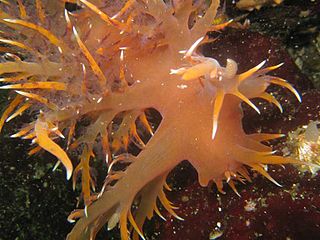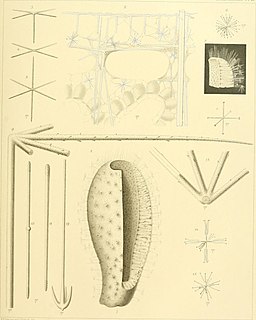
The Clathrinida are an order of calcareous sponges found in marine environments. These sponges have an asconoid structure and lack a true dermal membrane or cortex. The spongocoel is lined with choanocytes.

Edwardsia is a genus of sea anemones, the type of the family Edwardsiidae. They have eight mesenteries and live in tubes in the sand. The name, in New Latin, commemorates the French zoologist Henri Milne-Edwards.

Onchidorididae are a taxonomic family of sea slugs, dorid nudibranchs, marine gastropod molluscs in the superfamily Onchidoridoidea.

Homosclerophorida is an order of marine sponges. It is the only order in the monotypic class Homoscleromorpha. The order is composed of two families: Plakinidae and Oscarellidae.

Dendronotidae is a family of sea slugs, nudibranchs, marine gastropod mollusks in the superfamily Dendronotoidea. This family is within the clade Cladobranchia.

Cadlina is a genus of sea slugs, dorid nudibranchs, shell-less marine gastropod mollusks historically classified in the family Chromodorididae. Recent research by R.F. Johnson in 2011 has shown that Cadlina does not belong to the family Chromodorididae. She has therefore brought back the name Cadlinidae from synonymy with Chromodorididae. The family Cadlinidae also includes the genus AldisaBergh, 1878.

Dendronotus is a genus of sea slugs, nudibranchs, marine gastropod molluscs in the superfamily Tritonioidea.
Clathrina multiformis is a species of calcareous sponge from Russia.
Racekiela ryderi is a species of freshwater sponge in the family Spongillidae. It was first described by Edward Potts in 1882. It was collected on Sable Island in 1899 by John Macoun, a biologist with the Geological Survey of Canada, and given the name Heteromeyenia macouni by A.H. Mackay in 1900. It was originally assumed to be endemic to Sable Island but is now considered to be the same species as Racekiela ryderi, which is more broadly distributed.

Nephtheis fascicularis, commonly called the lollipop tunicate, lollipop coral, or blue palm coral, is a species of tunicate that is native to the shallow reefs of Indonesia. It is the only species in its genus Nephtheis. They are not photosynthetic, and live on plankton and small organic particles obtained from the water currents. The branched stems are formed by tiny polyps called zooids.

Aulactinia is a genus of sea anemones in the family Actiniidae.

Urticina is a genus of relatively large and often colorful sea anemones in the family Actiniidae from the North Pacific, North Atlantic and Arctic Oceans.

Dictyoceratida is an order of sponges in the subclass Ceractinomorpha containing five families. Along with the Dendroceratida, it is one of the two orders of demosponges that make up the keratose or "horny" sponges, in which a mineral skeleton is minimal or absent and a skeleton of organic fibers containing spongin, a collagen-like material, is present instead.
Onchimira is a genus of sea slugs, dorid nudibranchs, shell-less marine gastropod molluscs in the family Onchidorididae.

Oscarellidae is a family of marine sponges.
Onchimira cavifera is a species of sea slug, a dorid nudibranch, a shell-less marine gastropod mollusc in the family Onchidorididae.

Rossellidae is a family of glass sponges belonging to the order Lyssacinosa.
Dendronotus arcticus is a species of sea slugs, a dendronotid nudibranch, a shell-less marine gastropod mollusc in the family Dendronotidae.

Staurocalyptus is a genus of sponge. It was circumscribed in 1897 by Isao Ijima.












